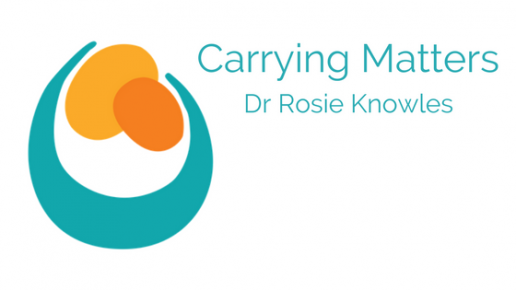Here are ten of some of the most frequently asked questions about slings we come across, the first in a series! Read on for the first Ten FAQs (part one).
- Which sling is the best?
- How do I keep my baby safe in my sling?
- What is the pelvic tuck?
- How can I support my baby’s wobbly head in their sling?
- What do the weight limits mean in practice?
- What should my baby wear in the sling?
- When is it safe to face my baby out in a sling?
- When can I start to back carry my child?
- My carrier doesn’t feel right!
- How do sling libraries work?
1) Which sling is the best?
This question is very much like asking “What is the best car?” I’m afraid there is no simple answer. The ‘best’ sling for you can depend on many factors
- your size/shape
- your child
- your budget
- your personal preferences
- your flexibility
- the activities you’d like to use the sling for, etc
We always recommend trying a sling on before making a commitment to buy. This is why sling libraries that allow you to hire them for a week or so, or specialist shops with trained staff (like Sling Spot) who can fit the carriers and show you how to use them are so useful. You are likely to save a lot of time and effort and find a sling that works for you with the support such services offer.
2) How do I keep my baby safe in my sling?
The “TICKS” guidelines are often referred to with this question. They are great if you are good at acronyms… However we often find people cannot remember them all and they can just add to the pressure. The TICKS are great to hand out for reading, but what about while you are actually putting baby in the sling?
Our top tips when checking safety are
- ‘Does your baby have an open airway that’s well supported?’
- ‘Are you hands-free?’
- ‘Are you both at a comfortable temperature?’
Remember, small and sleepy babies (especially under 3months) have a tendency to slump over, potentially closing their airway. Ensure your child’s chest and back are well supported.
Read more here.
the TICKS guidelines
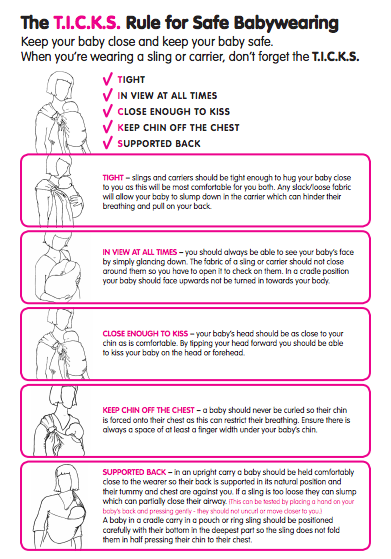
3) What is the pelvic tuck?
The pelvic tuck/tilt is how we create an ‘M position’ for younger babies as they rest on their parent. The knees are above bum, with the thighs rotated in the hip sockets. This has the effect of tilting baby’s pelvis upwards. This technique helps to ensure that baby’s lower spine is gently curved and that the chest is brought into close contact with the wearer’s body – the gentle J shape (as opposed to a curled up C shape). This will help to avoid slumping forwards which could compromise airway. It also creates a broader base that helps to support and stabilise the spine of a young baby.
Read more here.
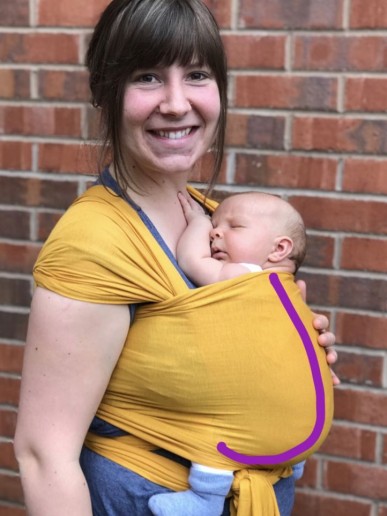
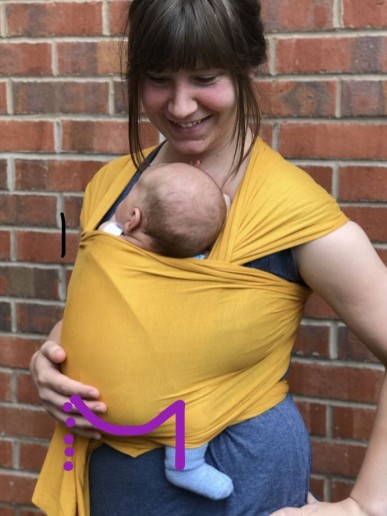
4) How can I support my baby’s wobbly head in their sling?
Young babies have not yet learned how to co-ordinate all their muscles to match the sensory feedback pouring into their brains; learning neck control to support the head confidently takes time. Sleepy babies have relaxed muscles and heads can loll around. This can be worrying for parents; but it is all part of how babies learn and develop.
The key thing is to ensure good upper back support, to stabilise a baby’s body. This is why the pelvic tuck and ensuring baby is chest to chest (on the front) is so important. It keeps their trunk and ribcage well supported so they don’t slump forwards into a C-shaped ball (which can compromise airway). If baby’s airway is clear and open, and the carrier is snug across their upper back. a little movement of baby’s head is fine. Learn how to adjust your carrier so your baby is stable.
You can use hoods, headrests, a layer of wrap fabric or a little rolled muslin to support a wobbly head when baby is asleep, if necessary (this is not a substitute for good positioning). Care must be taken that this does not tip baby’s head forwards (remember babies only have short necks with a large occiput so any pressure behind the back of the head can push their chin onto their chest.) When awake, giving them the opportunity to practice head control in the carrier is very useful!
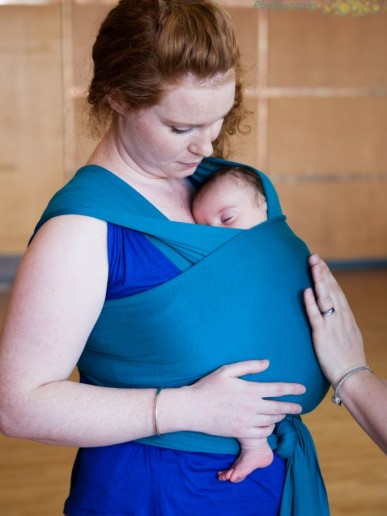
5) What do the weight limits mean in practice?
The ‘BS EN 13209-2:2015’ is the title of the weight testing for soft structured carriers in Europe. If a carrier has this referenced on their manuals then it will have been through this testing process. (There is a similar one in the USA.) This means is that sling has been entered into a specific weight parameter. If the sling withstands the weight then it passes (in the simplest of terms).
This is great in some respects because we can be sure that the construction (eg stitching around the straps etc) is secure for heavier weights, however we often find that the weight tested limit does not always correlate to the size of the child the carrier will accommodate. For example, a baby size carrier is often tested up to 15kg, which can be the weight of an average 3 year old. A child of this age and size is unlikely to be fully supported in a baby carrier, as the panel may be too short up their back (not reaching their armpits and allowing a lot of back leaning. A narrower base that suits a younger child may not give a 3yr old a comfortable seated position.
The carrier is likely to be able to bear their weight just fine but may not be the most comfy choice. It is worth mentioning that the weight “limits” do not mean the carrier will burst apart if you carry a heavier child in it, it is just the range that the carrier was tested to. Many will be fine at greater weights for short periods of time.
The carrier needs to fit the child adequately to meet the child’s needs for safety and comfort, as well as your own. This is why buying larger carriers for small children to grow into may mean the small child is not safely supported within the panel and it may not be safe or comfy for them right now.
You can read more on this in this article “Beyond the Knee to Knee“.
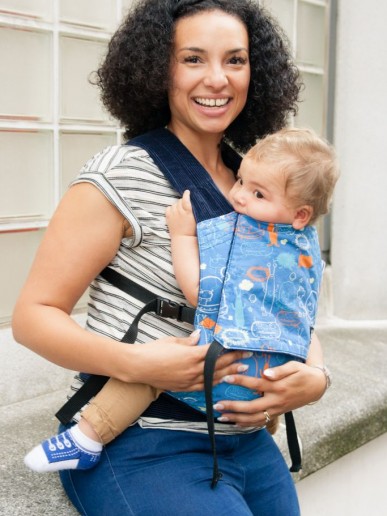
6) What should my baby wear in the sling?
This one can be tricky, especially with the ever-changing weather in the UK! A good way to start is to use several layers and match the layers and their thickness with your baby; if you are cold/warm, your baby will be feeling the same. The sling adds at least an extra layer, maybe more if the panel is thick or if there are multiple passes of fabric (eg a thicker stretchy wrap with its three layers can be very warm in summer). Babies are more at risk of breathing problems if they are too hot, so do be aware and be able to remove layers easily if needed.
If it’s hot then dress down accordingly and ensure you are both drinking lots of fluids. More about warm weather slings here.
If it’s cold, then a larger sized coat or babywearing coat over the both of you, or an extra panel attached to the front or a sling cover attached to straps can work nicely. When you walk you generate heat, and subsequently share that heat with your little one. With this type of extra layering, you can unzip and expel heat gently if needed. That way you don’t need to disturb your baby by taking them out of the sling to remove layers. More about winter babywearing here.
Be cautious with footed pajamas or onesies, as they can ride up in the sling and end up pulling on tender toes, you may wish to size up. In warm weather, carrier edges can rub against the delicate skin of thighs and knees, thin leggings or leg warmers may be useful to prevent friction (along with a good pelvic tuck to raise the knees.)
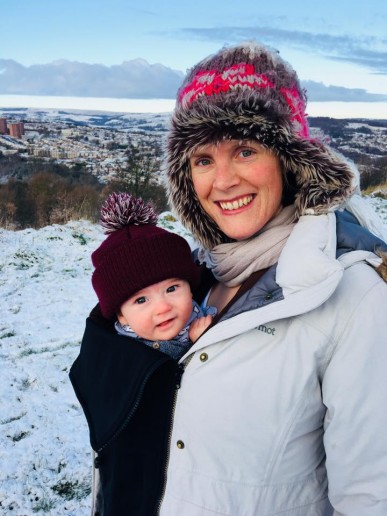
7) When is it safe to face my baby out in a sling?
There are many schools of thought when it comes to outward facing and ultimately, it is up to the child/carer dyad to decide what works best for their circumstances. You can read more about the pros and cons here.
If you do opt to face your child out, here are few safety points.
- A baby should have consistent and sustainable upper back and neck control to be outward facing. A baby’s upper body may be less well supported facing out, which can increase the risk of slumping and airway compromise, and parent/carer can’t see or feel their breathing in the same way with inward facing. Typically, this is around 4months, but it does vary.
- The panel should not obstruct the airway. Your child’s chin must easily clear the top of the panel so that they can breathe freely.
- If baby falls asleep you must turn them inwards, to ensure their airway remains open and you can monitor it safely.
- The carrier should be specifically designed for outward facing. Some carrier companies have put more careful thought into how to do this well, focusing on safety and comfort for a child as well as for the parent/carer. Please be aware that there will be more strain on your shoulders with some types of carrier that put baby in a less seated position, and please ensure the fabric does not rub or pinch your child’s thighs.
- Please follow the manufacturers instructions on how to adjust the carrier to face outwards, you will usually need to adjust the panel shape.
- Manufacturers often suggest outward facing is limited to 20 minutes at a time. This is to ensure parents/carers check on their children regularly, and to encourage them to be aware that their baby may be becoming tired. Young babies are less able to ignore sensory information and the world is a very stimulating experience. Outward facing does not offer a child a chest/shoulder to snuggle into and switch off. Some babies may have had enough after only ten minutes, however, a child who is well rested, well fed, and very content and awake does not need to be automatically turned around after 20 minutes; know your child and be responsive!
- It’s important to take regular breaks for re-connection. Your baby needs to see your face frequently in the early months before they have grasped “object permanence”.
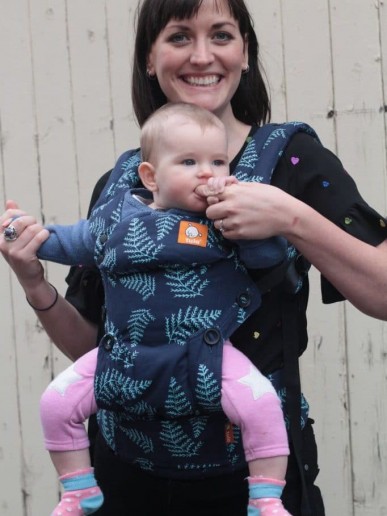
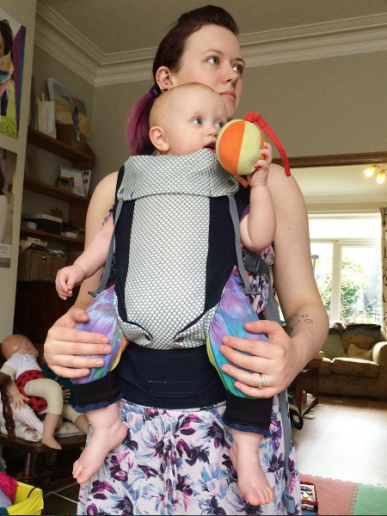
8) When can I start to back carry my child?
Back carrying can be a wonderful experience for a curious child wanting to see more of the world, or for a parent who feels exhausted by the demands of feeding and front carrying. You can back carry from almost any age, once you know how and have the right tools.
When it is right for you to back carry will depend on a few things
- The sling you are using
- Your skill level
- Your desire to back carry
Many women around the globe back carry from very young, with traditional cloths, building on their generations of shared community skills. Many Western babywearers no longer have these skills and tend to use long woven wraps. You may wish to back carry from birth with the use of a light and soft woven wrap. This will allow you to keep your young baby high so you can feel their breathing on your neck for reassurance. Many meh dais also allow early and high back carrying too. If you are new to carrying, please seek in person support from your local consultant as this is a more complex skill and can take time to master.
With a more structured carrier (eg a full buckle carrier) many people prefer to wait until baby is virtually sitting unaided as this stage of development makes it just easier and simpler to do well. These structured carriers don’t offer the same level of precision tightening as a woven wrap, and can only be tightened to the parameters of the panel. Young and small babies who lack torso and upper back strength may slump over in looser panels. High back carrying is harder with most waistbanded carriers; baby often ends up lower down on the back and it isn’t as easy to monitor their airway from here.
This doesn’t apply to children with disabilities of course; children can be back carried with the right support and the right tools; please seek support from a professional about this.
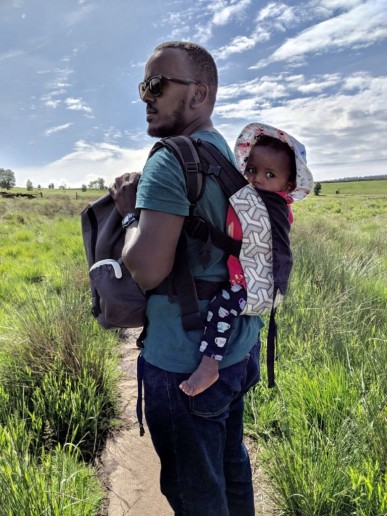
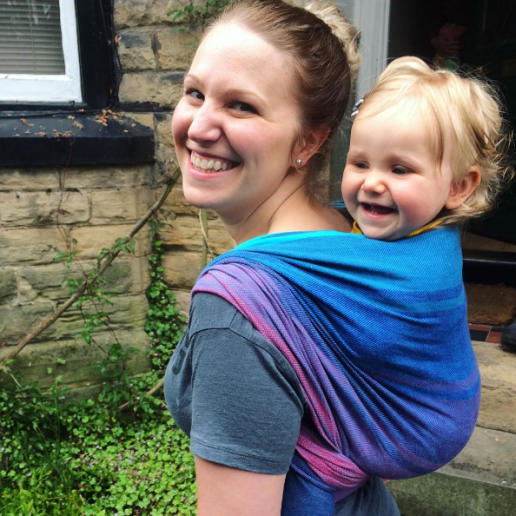
9) My carrier doesn’t feel right!
If a sling or carrier feels wrong, please trust your instincts. Take your baby out and have a break. It is easier to learn how to use a sling when you are calm and in a learning mode, rather than when you and baby are both distressed. Have a look at the instructions again and perhaps practice with a teddy to see how to fasten it together.
If you are using the sling according to instructions but it still doesn’t feel right, do your safety checks again. Check the carrier is tight and secure. If you feel like you can lift your baby up and closer to you even though they are in the sling, the straps are too loose. Ensure baby’s back is fully supported and one leg isn’t much lower than the other, and that baby’s airway is unobstructed.
Some carriers may be easier to get to grips with than others; keep practising, and do get in touch with your local sling library or friendly online babywearing group who can give you some troubleshooting tips. They may be able to show you how to get your straps feeling more comfy, or adjust the panel so that it holds baby better, or show you how to tighten things more easily.
It may be that your baby carrier just doesn’t fit you or your baby; this is what sling libraries are for; they will help you find something that works!
If your baby cries in the sling, read this.
If your buckle carrier is uncomfy for you, this troubleshooting guide may help.
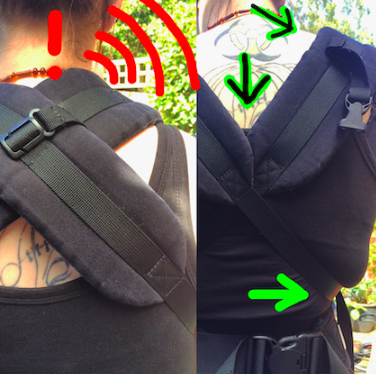
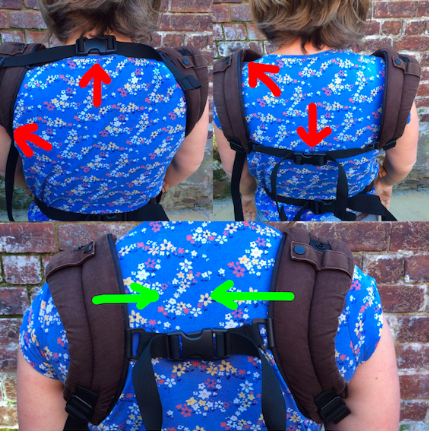
10) How do sling libraries work?
Sling libraries work very much like book libraries, and offer you the chance to try a range of carriers with an experienced guide.
Many will have a catalogue of slings which you can browse, try on and hire. Library sessions are usually on set dates during the month and are usually run by volunteers.
During these drop in sessions you will be welcomed and informed that each family typically receive about 10-15 minutes of support. A consultant or peer supporter will then talk through what your requirements are and assist you in trying a few slings. If you’d like to hire to see how the carrier feels at home, in real circumstances, many libraries offer this facility for a small fee. If you want to bring your own sling for support then please do, the librarians and volunteers are keen to help others love carrying as much as they do!
Please note these library sessions can sometimes get busy so if that doesn’t suit you, it might be worth looking at booked 1-2-1 sessions, which are much more dedicated to you and your child’s particular needs, much calmer and you get more in depth help!
Your local library can be found at http://www.slingpages.co.uk
This is based on a live blog with Kiri Porter for the Sheffield Sling Surgery; “ten FAQs about slings!”

